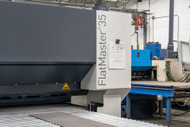Knife Blades Steel Grades Guide
Oct 30th 2025
If you want to make or buy a great knife, you need to understand knife blade steel grades. The grade you choose directly affects edge retention, toughness, corrosion resistance, and overall performance.
Tim Gelnett, Vice President of Niagara Specialty Metals, compared it to cars: “There are different levels, just like in the auto industry—you’ve got Chevy, Lexus, and Ferrari. Knife steels are no different.”
Here’s what that looks like when you’re deciding which grade is right for you.

Entry-Level Grades: Affordable, But Limited
Basic carbon steels and lower-cost stainless steels are common in budget knives. They’re inexpensive, but they dull quickly and offer poor corrosion resistance. As Tim said, “Carbon steels are very cheap. There’s a lot of it out there, but we don’t sell it at all.”
If you’re an enthusiast or a maker focused on quality, these grades may leave you—or your customers—disappointed.
Mid-Grade Steels: Reliable Workhorses
Steels like D2 and 440C stainless are the “average knife grades.” They balance durability and corrosion resistance, making them common choices for production knives and mid-tier blades. As Tim noted, “D2 and 440C are your average knife grades.”
These steels are a step up from entry-level grades, but they don’t offer the advanced performance of modern powder metallurgy steels.
Premium PM Steels: Performance You Can Feel
If you’re building knives for demanding users, powder metallurgy (PM) steels are where you should focus. CPM S35VN, CPM S90V, and CPM 3V are just a few examples. Tim explained:
“Some grades are better in saltwater, like MagnaCut. Others, like CPM 3V, are all about toughness. And then you’ve got S90V, which has the highest wear resistance.”
These steels let you craft blades that stay sharper longer, resist rust, and perform under extreme conditions.
The Game-Changer: MagnaCut
If you want the best balance of properties in one steel, MagnaCut is the clear choice. It delivers toughness, edge retention, and corrosion resistance all in one package. Tim shared just how popular it has become:
“For a while there, I was selling 30,000 pounds a month of MagnaCut sheet product. It’s amazing to know how many knives are made from that one grade alone.”
For you, that means you can make or buy a knife that performs in the kitchen, in the field, or anywhere else—without compromise.
Why Grade Selection Matters for You
If you’re a small shop, you may feel overlooked by distributors who only want large orders. Tim emphasized, “A lot of small guys don’t like calling distributors because they feel like they won’t get serviced. That’s why we want to make sure they can buy direct when they need it.”
When you understand knife blade steel grades, you can confidently choose the material that matches your purpose—and your customers will notice the difference.
Final Thoughts
From basic carbons to advanced PM steels, knife blade steel grades define performance. If you want a blade that cuts longer, resists corrosion, and stands up to real use, focus on grades that deliver toughness, edge retention, and corrosion resistance.
As Tim summed it up: “I consider Niagara the masters of the knife market. It’s our job to educate and support makers so they know the difference between one grade and another.”
Whether you’re buying or building, knowing your knife blade steel grades gives you the power to choose blades that last.




